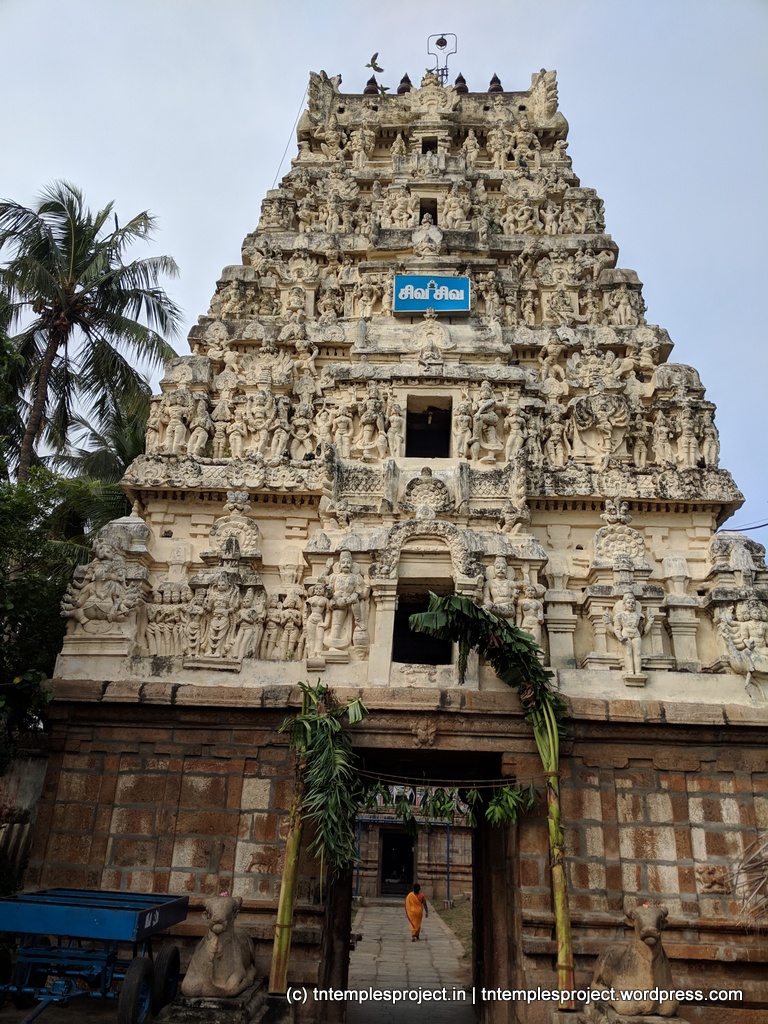Basic information about the temple
| Moolavar: | Satyavakeeswarar | Ambal / Thayar: | Soundara Nayaki |
| Deity: | Siva | Historical name: | Tiruanbil |
| Vriksham: | Aalamaram | Teertham: | Chandra Teertham |
| Agamam: | Age (years): | ||
| Timing: | 6 to 11 & 5 to 8 | Parikaram: | |
| Temple group: | Paadal Petra Sthalam (Kaveri Vada Karai) | – | |
| Sung by: | Temple set: | ||
| Navagraham: | Nakshatram: | ||
| City / town: | Anbil | District: | Tiruchirappalli |
| Maps from (click): | Current location | Tiruchirappalli (29 km) | Thanjavur (37 km) |
| Ariyalur (45 km) | Perambalur (51 km) |
Location
Anbil is located east of Lalgudi, on the northern banks of the Kollidam river, and is about 30 km from Trichy / 22km from Srirangam.
Sthala puranam and temple information

Located on the northern bank of the Kollidam river, one of the ancient names of this temple is Anbil Alanthurai (Anbil being the name of the town, and Alanthurai referring the temple). This is considered the location where Lord Siva consumed the deadly halahala poison that emerged from the churning of the ocean. Another possible reason for the name of the place is that this was a banyan forest (ala = banyan in Tamil), and the sthala vriksham here is also a banyan tree.
Sage Vageesar once performed a penance at this place, worshipping Lord Siva, and so the Lord here is called Satyavakeeswarar. Brahma also worshipped Lord Siva here, for which reason the Lord here also has the name Brahmapureeswarar. This name is also attested to by inscriptions at this temple.
Siva wanted to test Sambandar, and so He made the river Kaveri overflow in floods, to prevent Sambandar from visiting the temple. Sambandar sang a pathigam praising the Lord, from the opposite (Southern) bank of the Kollidam river, and eventually the floods abated, letting him perform his worship properly. It is believed that Vinayakar at this temple tilted his head and ears to one side so that He could hear Sambandar’s song properly – for this reason, he is called Sevi Saaitha Vinayakar (in Tamil, sevi = ear, saaitha = turned). It is believed that prayers to this Vinayakar helps cure devotees who have hearing trouble.
Parantaka Chola brought in 108 agnihotris to Tamilakam. One of those – sage Jaimini – performed Sama Veda recitation here, which Vinayakar is said to have listened to intently. So the Vinayakar here is also called Sama Gaanam Ketta Vinayakar.
Typically, the Navagrahams are arranged such that Suryan faces the east, and none of the other grahams face any other. Here, Suryan is turned west, facing the Lord, and all the other grahams face Suryan.
It is believed that this temple as well as the nearby Anbil Sundararaja Perumal temple (a Divya Desam) – about 500m away – were both so large at one time, that they shared that temple’s Manduka Teertham as a common temple tank.

This is a Chola temple, initially built by Parantaka Chola. It is believed that prior to that, this may have been a maadakoil (built by Kochchenga Cholan). Unusually for this region, the Lingam is on a square avudai (this is normally a feature of Siva temples in Pandya nadu). Both Siva and Parvati face east, which represents kalyana kolam.
The Anbil Plates are a set of copper inscriptions which, along with others such as the Tiruvalangadu plates and the Leiden plates, are the only epigraphical records that give genealogical lists of the Chola kings. There are several inscriptions at this temple indicating grants given to the temple by Maravarman Kulasekara Pandiyan, Rajendra Chola III, Hoysala king Veeraramanathadevar, and Madurai Konda Parakesari Varman.
Located close by is the Anbil Sundararaja Perumal temple – a Divya Desam temple.
Other information for your visit
There is also a Mariamman temple in Anbil, where the Goddess is considered to be the sister of Samayapuram Mariamman. Satyavakeesa Vinayakar has a separate temple to the southeast of this temple.
Contact
Gallery





















